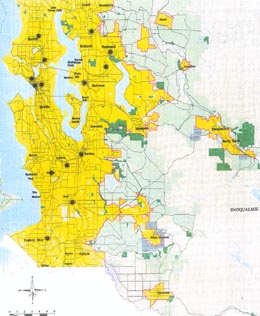On November 18, 1994, the Metropolitan King County Council approves a new Comprehensive Plan to guide and regulate growth and land development in the county. The Plan is one of many measures required by the Growth Management Act (GMA), recently passed by the State Legislature to prevent sprawl and uncontrolled growth. Based on countywide planning policies developed jointly by county and city officials, the Plan identifies an urban-growth boundary and strictly limits development east of that line; prescribes regulations for urban and rural land use, protecting the natural environment and resources such as agriculture, forestry, and mining; and provides for building the transportation and other infrastructure necessary to serve anticipated growth.
The Growth Management Act
The state Legislature passed the Growth Management Act in 1990 (with major additions in 1991) in response to voter anger over increasing traffic congestion, pollution, suburban sprawl, loss of open space, and other consequences of unchecked growth. The Act directed the state's large and fast-growing counties and the cities within those counties to prepare comprehensive plans to guide and regulate future land use, housing, public facilities and utilities, and transportation. The plans, to be based on countywide planning policies developed jointly by county and city officials, had to meet many requirements imposed by the GMA, such as ensuring that transportation, public facilities, and utilities were adequate for proposed new development.
Because concerns over growth had been a significant political factor in King County at least since the 1970s, the County's 1985 Comprehensive Plan anticipated and included many elements later required by the GMA. Nonetheless the 1990 passage of the state law triggered a four-year process leading to adoption of a new GMA Comprehensive Plan for the County.
The planning process began with the preparation of countywide planning policies by a committee of county and city officials called the Growth Management Planning Council. The Council issued the first policies (Phase I) in 1992. These policies established an urban-growth boundary, required by the GMA, dividing the already-urbanized western portion of the county, where new urban growth was permitted (and required), from the rural eastern portions where only limited future development was allowed. Although the boundary was denounced from both sides of the line and was unpopular with some growth-control supporters as well as property-rights activists, the King County Council and Seattle and other cities ratified the Phase I policies by the October 1992 deadline.
Comprehensive Planning
By then, the Growth Management Planning Council was already working on additional Phase II countywide planning policies. This included the challenging and controversial process of identifying where within the urban-growth area the densest growth would be directed. After months of debate and deadlock, King County Executive (and future governor) Gary Locke (b. 1950) helped the county and city members of the Planning Council reach agreement on policies that called for 14 urban centers to take the bulk of new growth. The agreement in the Growth Management Planning Council came on May 26, 1994, and the King County Council adopted the approved policies the following August 15. Ratification by cities came in December, but by then the County Council had already approved the Comprehensive Plan based on the policies.
The Comprehensive Plan, consisting of a 255-page volume and hundreds of additional pages of appendices, was drafted over several years by the King County Department of Development and Environmental Services and King County Council staff. As required by the GMA, it contained sections setting strategies and requirements for urban and rural land use; economic development; housing; natural resource (forest, agriculture, and mining) lands; the natural environment; facilities and services; transportation; parks, recreation, and open space; cultural resources; energy and telecommunications; and planning and implementation.
The draft Comprehensive Plan came before the King County Council for a final vote on November 18, 1994. Most of the attention that evening centered on controversial proposals to remove some land in the Kent Valley from the agricultural designation to allow uses other than farming and to allow commercial development in a portion of rural Happy Valley east of Redmond. Except for one Kent Valley parcel, the proposals were defeated. Although the urban-growth area in the Plan as passed was slightly larger than that in the 1992 countywide planning policies, the Plan's urban-growth boundary essentially followed that adopted in 1992.
"A Blueprint for Growth"
The final vote to approve the Comprehensive Plan was 12 to 1, with Republican Kent Pullen (1943-2003) voting no. Before the vote, council members stood and applauded their staff who had worked on completing the Plan. Members from both parties praised the adopted Plan. Democrat Larry Phillips (b. 1956) said "We've established a blueprint for growth in our community that will last for generations to come" (Gupta, "County Council Passes ..."). Republican Chris Vance said, "Almost no other county is where we are. This is the biggest step forward. We have a plan full of lots of good things" (Gupta, "County Council Passes ...").
As required by the GMA, in the weeks after approving the Plan, the Council considered and adopted development regulations -- including zoning provisions, protections, and limitations on development for environmentally critical areas, and special regulations governing shorelines -- to implement and enforce the policies outlined in the Plan. As with the Plan itself, many regulations were based on measures adopted even before the GMA became law. For instance, the Sensitive Areas Ordinance, which was highly controversial when passed in 1990, already protected critical areas like wetlands.
King County has made minor changes and technical amendments to the Comprehensive Plan on an annual basis since adopting it. In 2000, the County began a Four-Year Cycle for review and consideration of major changes. The 2000 and 2004 Updates found that the Plan adopted in 1994 remained viable, and many basic elements of the that Plan, including the urban-growth boundary, remain largely unchanged.

